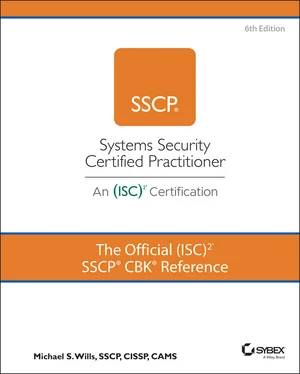Mike Wills - The Official (ISC)2 SSCP CBK Reference
Здесь есть возможность читать онлайн «Mike Wills - The Official (ISC)2 SSCP CBK Reference» — ознакомительный отрывок электронной книги совершенно бесплатно, а после прочтения отрывка купить полную версию. В некоторых случаях можно слушать аудио, скачать через торрент в формате fb2 и присутствует краткое содержание. Жанр: unrecognised, на английском языке. Описание произведения, (предисловие) а так же отзывы посетителей доступны на портале библиотеки ЛибКат.
- Название:The Official (ISC)2 SSCP CBK Reference
- Автор:
- Жанр:
- Год:неизвестен
- ISBN:нет данных
- Рейтинг книги:4 / 5. Голосов: 1
-
Избранное:Добавить в избранное
- Отзывы:
-
Ваша оценка:
- 80
- 1
- 2
- 3
- 4
- 5
The Official (ISC)2 SSCP CBK Reference: краткое содержание, описание и аннотация
Предлагаем к чтению аннотацию, описание, краткое содержание или предисловие (зависит от того, что написал сам автор книги «The Official (ISC)2 SSCP CBK Reference»). Если вы не нашли необходимую информацию о книге — напишите в комментариях, мы постараемся отыскать её.
The Official (ISC)2 SSCP CBK Reference
SSCP Study Guide
The Official (ISC)2 SSCP CBK Reference
The Official (ISC)2 SSCP CBK Reference — читать онлайн ознакомительный отрывок
Ниже представлен текст книги, разбитый по страницам. Система сохранения места последней прочитанной страницы, позволяет с удобством читать онлайн бесплатно книгу «The Official (ISC)2 SSCP CBK Reference», без необходимости каждый раз заново искать на чём Вы остановились. Поставьте закладку, и сможете в любой момент перейти на страницу, на которой закончили чтение.
Интервал:
Закладка:
Exfiltration generally occurs in part because decisions have been made to ignore risks, disregard alarm indications, and knowingly operate information systems in insecure ways. (There are cases of data breaches that happen to highly secure systems, hardened to the best possible standards, but these are few and far between.)
Inadvertent exposure can happen due to carelessness, due to accident, or through faulty design of business processes or information security measures.
An expression of an idea must, in almost all cases, be labeled or declared as a protected idea; this is how its owner asserts rights against possible infringement. This first assertion of a claim of ownership provides the basis for seeking legal means to stop the infringement, seek damages for lost business, or enter into licensing arrangements with the infringers.
Each of these possible exposures to loss starts with taking proper care of the data in the first place. This requires properly classifying it (in terms of the restrictions on handling, use, storage, or dissemination required), marking or labeling it (in human-readable and machine-readable ways), and then instituting procedures that enforce those restrictions.
Software, Digital Expression, and Copyright
Most software is protected by copyright, although a number of important software products and systems are protected by patents. Regardless of the protection used, it is implemented via a license. Most commercially available software is not actually sold; customers purchase a license to use it, and that license strictly limits that use. This license for use concept also applies to other copyrighted works, such as books, music, movies, or other multimedia products. As a customer, you purchase a license for its use (and pay a few pennies for the DVD, Blu-Ray, or other media it is inscribed upon for your use). In most cases, that license prohibits you from making copies of that work and from giving copies to others to use. Quite often, they are packaged with a copy-protection feature or with features that engage with digital rights management (DRM) software that is increasingly part of modern operating systems, media player software applications, and home and professional entertainment systems. It is interesting to note that, on one hand, digital copyright law authorizes end-user licensees to make suitable copies of a work in the normal course of consuming it—you can make backups, for example, or shift your use of the work to another device or another moment in time. On the other hand, the same laws prohibit you from using any reverse engineering, tools, processes, or programs to defeat, break, side-step, or circumvent such copy protection mechanisms. Some of these laws go further and specify that attempts to defeat any encryption used in these copy protection and rights management processes is a separate crime itself.
These laws are part of why businesses and organizations need to have acceptable use policies in force that control the use of company-provided IT systems to install, use, consume, or modify materials protected by DRM or copy-protect technologies. The employer, after all, can be held liable for damages if they do not exert effective due diligence in this regard and allow employees to misuse their systems in this way.
Copyleft?
By contrast, consider the Creative Commons license, sometimes referred to as a copyleft. The creator of a piece of intellectual property can choose to make it available under a Creative Commons license, which allows anyone to freely use the ideas provided by that license so long as the user attributes the creation of the ideas to the licensor (the owner and issuer of the license). Businesses can choose to share their intellectual property with other businesses, organizations, or individuals by means of licensing arrangements. Copyleft provides the opportunity to widely distribute an idea or a practice and, with some forethought, leads to creating a significant market share for products and services. Pixar Studios, for example, has made RenderMan, its incredibly powerful, industry-leading animation rendering software, available free of charge under a free-to-use license that is a variation of a creative commons license. In March 2019, the National Security Agency made its malware reverse engineering software, called Ghidra, publicly available (and has since issued bug fix releases to it). Both approaches reflect a savvy strategy to influence the ways in which the development of talent, ideas, and other products will happen in their respective marketplaces.
Industrial or Corporate Espionage
Corporations constantly research the capabilities of their competitors to identify new opportunities, technologies, and markets. Market research and all forms of open source intelligence (OSINT) gathering are legal and ethical practices for companies, organizations, and individuals to engage in. Unfortunately, some corporate actors extend their research beyond the usual venue of trade shows and reviewing press releases and seek to conduct surveillance and gather intelligence on their competitors in ways that move along the ethical continuum from appropriate to unethical and, in some cases, into illegal actions. In many legal systems, such activities are known as espionage , rather than research or business intelligence, as a way to clearly focus on their potentially criminal nature. (Most nations consider it an illegal violation of their sovereignty to have another nation conduct espionage operations against it; most nations, of course, conduct espionage upon each other regardless.) To complicate things even further, nearly all nations actively encourage their corporate citizens to gather business intelligence information about the overseas markets they do business in, as well as about their foreign or multinational competitors operating in their home territories. The boundary between corporate espionage and national intelligence services has always been a blurry frontier.
When directed against a competitor or a company trying to enter the marketplace, corporate-level espionage activities that might cross over an ethical or legal boundary can include attempts to do the following:
Establish business relationships to gain federated access to e-business information such as catalogs, price lists, and specifications
Gather product service or maintenance manuals and data
Recruit key personnel from the firm, either as new employees or as consultants
Engaging in competitive, information-seeking arrangements with key suppliers, service vendors, or customers of the target firm
Probing and penetration efforts against the target's websites and online presence
Social engineering efforts to gather intelligence data or provide the reconnaissance footprint for subsequent data gathering
Unauthorized entry or breaking into the target's property, facilities, or systems
Visiting company facilities or property, ostensibly for business purposes, but as intelligence-gathering
All of the social engineering techniques used by hackers and the whole arsenal of advanced persistent threat (APT) tools and techniques might be used as part of an industrial espionage campaign. Any or all of these techniques can and often are done by third parties, such as hackers (or even adolescents), often through other intermediaries, as a way of maintaining a degree of plausible deniability.
You will probably never know if that probing and scanning hitting your systems today has anything to do with the social engineering attempts by phone or email of a few weeks ago. You'll probably never know if they're related to an industrial espionage attempt, to a ransom or ransomware attack, or as part of an APT's efforts to subvert some of your systems as launching pads for their attacks on other targets. Protect your systems against each such threat vector as if each system does have the defense of the company's intellectual property “crown jewels” as part of its mission. That's what keeping confidences , what protecting the confidential, proprietary, or business-private information, comes down to, doesn't it?
Читать дальшеИнтервал:
Закладка:
Похожие книги на «The Official (ISC)2 SSCP CBK Reference»
Представляем Вашему вниманию похожие книги на «The Official (ISC)2 SSCP CBK Reference» списком для выбора. Мы отобрали схожую по названию и смыслу литературу в надежде предоставить читателям больше вариантов отыскать новые, интересные, ещё непрочитанные произведения.
Обсуждение, отзывы о книге «The Official (ISC)2 SSCP CBK Reference» и просто собственные мнения читателей. Оставьте ваши комментарии, напишите, что Вы думаете о произведении, его смысле или главных героях. Укажите что конкретно понравилось, а что нет, и почему Вы так считаете.












